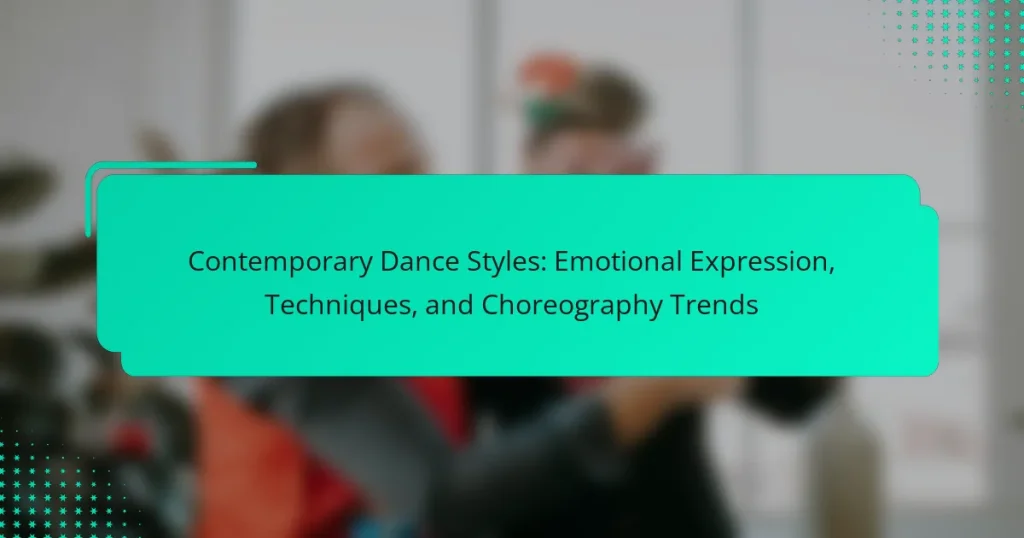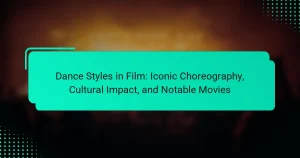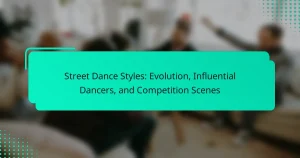Contemporary dance styles are diverse forms of movement that emerged in the mid-20th century, integrating elements from ballet, jazz, and modern dance. These styles prioritize individual expression, creativity, and emotional exploration, with notable techniques including lyrical, release technique, and postmodern dance. Current trends in choreography highlight the use of technology, multimedia, and site-specific performances, while also emphasizing collaboration with artists from various disciplines. Additionally, contemporary dance increasingly addresses social and political themes and explores personal narratives, fostering deeper emotional connections. Engaging with contemporary dance can be achieved through classes, workshops, performances, and community involvement, enhancing understanding and appreciation of this dynamic art form.
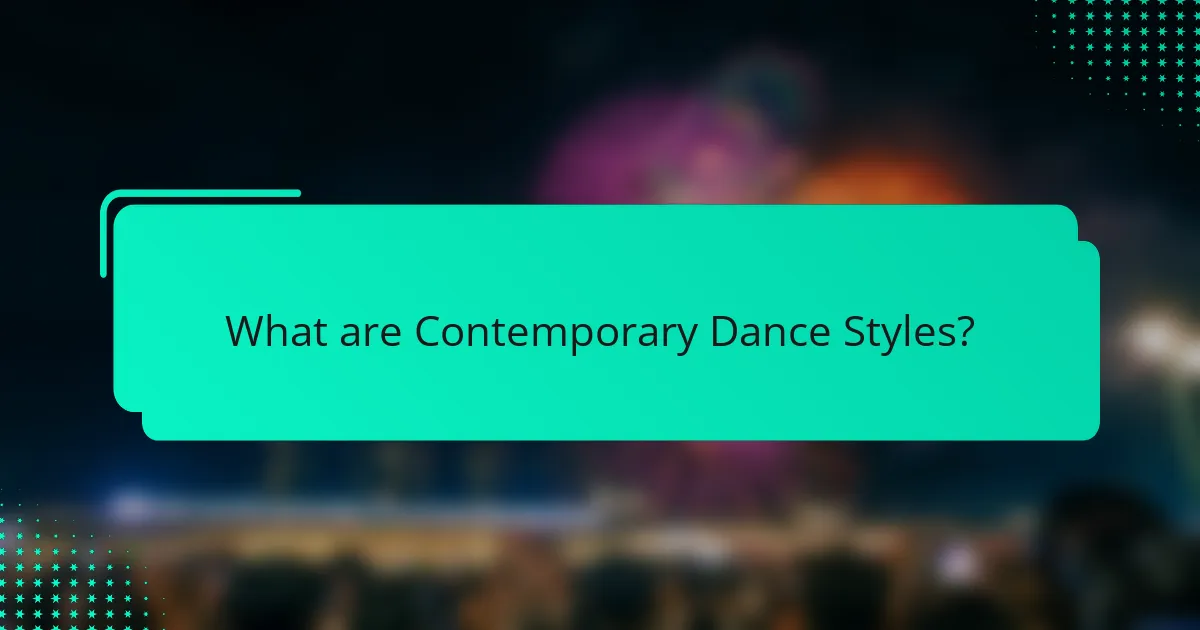
What are Contemporary Dance Styles?
Contemporary dance styles are diverse forms of dance that emerged in the mid-20th century. They blend elements from various genres including ballet, jazz, and modern dance. Contemporary dance emphasizes individual expression and creativity. It often incorporates improvisation and explores themes of emotion and human experience. Notable styles include lyrical, release technique, and postmodern dance. These styles prioritize fluidity and the use of the body in innovative ways. Contemporary dance is characterized by its adaptability and evolution over time. It reflects cultural changes and societal issues, making it a dynamic art form.
How do Contemporary Dance Styles differ from other dance forms?
Contemporary dance styles differ from other dance forms by emphasizing individual expression and fluidity. They often incorporate elements from various genres, including ballet, jazz, and hip-hop. Unlike traditional forms, contemporary dance prioritizes creative movement over strict technique. This style encourages improvisation and personal interpretation. Contemporary choreography frequently addresses emotional themes and societal issues. It adapts to current cultural contexts, making it highly relevant. The use of varied music styles further distinguishes contemporary dance. Dancers often perform barefoot, enhancing connection with the floor. Overall, contemporary dance is defined by its versatility and focus on personal narrative.
What historical influences shaped Contemporary Dance Styles?
Contemporary dance styles were shaped by various historical influences including modern dance, ballet, and cultural movements. Modern dance emerged in the early 20th century as a reaction against classical ballet. Pioneers like Martha Graham and Isadora Duncan emphasized personal expression and natural movement. Ballet’s technical precision also influenced contemporary techniques, blending classical elements with modern freedom. Additionally, cultural movements such as the civil rights movement and feminist movements infused social themes into choreography. The integration of diverse styles, including jazz and hip-hop, further enriched contemporary dance. These influences collectively fostered a dynamic form that prioritizes emotional expression and individual creativity.
What are the key characteristics of Contemporary Dance Styles?
Contemporary dance styles are characterized by their blend of various dance forms and techniques. They emphasize emotional expression and personal interpretation. This style often incorporates elements from ballet, jazz, and modern dance. Contemporary dance is known for its versatility and adaptability. Dancers frequently use floor work, improvisation, and unique body movements. The choreography often reflects current social and cultural themes. Additionally, contemporary dance can be performed to a wide range of music genres. This flexibility allows for innovative and creative performances.
Why is emotional expression important in Contemporary Dance?
Emotional expression is crucial in Contemporary Dance because it enhances the connection between the dancer and the audience. This form of dance emphasizes individuality and personal storytelling. Dancers convey emotions through movement, allowing audiences to experience a range of feelings. Research shows that emotional expression can significantly impact audience engagement and interpretation. For instance, studies indicate that performances rich in emotional content are more memorable. This connection fosters empathy and understanding. Therefore, emotional expression serves as a vital tool in creating impactful and resonant dance experiences.
How do dancers convey emotions through movement?
Dancers convey emotions through movement by using body language, [censured] expressions, and physical technique. Their movements can depict joy, sadness, anger, or fear. For example, quick, sharp movements may express anger, while flowing, soft movements can convey sadness. The use of space and dynamics also enhances emotional expression. Dancers often utilize levels and directions to communicate feelings. Research indicates that specific movements correlate with emotional states, as shown in studies by authors like William Forsythe. These findings demonstrate the effectiveness of movement in conveying complex emotions.
What techniques enhance emotional expression in Contemporary Dance?
Techniques that enhance emotional expression in Contemporary Dance include improvisation, physical storytelling, and the use of space. Improvisation allows dancers to explore and convey genuine emotions spontaneously. Physical storytelling involves using body movements to narrate feelings and experiences. The use of space emphasizes the dancer’s relationship with their environment, adding depth to emotional expression. Research by the National Dance Education Organization highlights how these techniques facilitate a deeper connection between the dancer and the audience. These methods encourage vulnerability, making the emotional experience more relatable.
What techniques are commonly used in Contemporary Dance?
Contemporary dance commonly uses techniques such as release technique, floor work, and improvisation. Release technique focuses on the body’s natural movements and gravity. It emphasizes relaxation and fluidity in motion. Floor work involves dancing on the floor, allowing for a connection to the ground. This technique enhances body awareness and control. Improvisation encourages spontaneity and creativity in movement. Dancers explore their physicality and express emotions through unscripted actions. Additionally, contemporary dance incorporates elements from ballet and modern dance. These foundational styles provide structure and vocabulary for contemporary choreography. Techniques in contemporary dance promote emotional expression and personal storytelling.
What are the foundational techniques in Contemporary Dance?
Foundational techniques in Contemporary Dance include release technique, contraction and release, and floor work. Release technique emphasizes relaxation and gravity to enhance movement flow. Contraction and release, developed by Martha Graham, focuses on the body’s response to tension and relaxation. Floor work involves movements performed close to or on the ground, enhancing a dancer’s connection to the floor. These techniques promote emotional expression and physical awareness. They are essential for developing a dancer’s versatility and creativity in contemporary choreography.
How do improvisation and choreography interact in Contemporary Dance?
Improvisation and choreography interact dynamically in Contemporary Dance. Choreography provides a structured framework for dancers. This framework outlines specific movements and formations. Improvisation allows dancers to explore creativity within this structure. Dancers can interpret choreography in personal ways. This interaction enhances emotional expression in performances. Research shows that improvisation fosters spontaneity and adaptability. This adaptability can lead to innovative choreography. The blend of both elements enriches the overall dance experience.
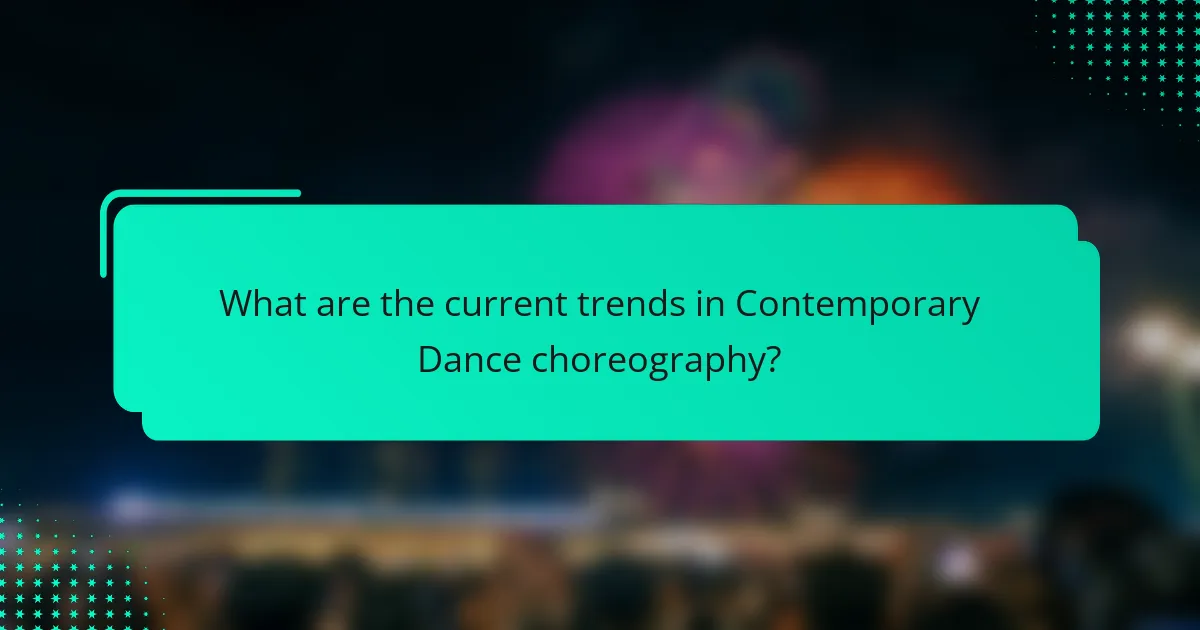
What are the current trends in Contemporary Dance choreography?
Current trends in Contemporary Dance choreography include increased use of technology and multimedia. Choreographers are integrating digital elements into performances. This can involve projection mapping and interactive installations. There is also a focus on site-specific work. Dancers are performing in non-traditional spaces, which enhances the audience experience.
Moreover, collaboration across disciplines is becoming more common. Choreographers are partnering with visual artists, musicians, and filmmakers. This trend creates a more immersive experience. Another trend is the emphasis on social and political themes. Choreographers are addressing current issues through movement.
Finally, the exploration of identity and personal narratives is prevalent. Dancers are sharing their stories, which fosters emotional connection. These trends reflect the evolving nature of Contemporary Dance.
How has technology influenced Contemporary Dance choreography?
Technology has significantly influenced Contemporary Dance choreography by introducing new tools and methods for creation. Digital media allows choreographers to experiment with visual elements, enhancing the storytelling aspect of performances. Video editing software enables the integration of multimedia, creating immersive experiences for audiences. Motion capture technology provides insights into body movement, allowing for precise choreography adjustments. Additionally, online platforms facilitate collaboration among dancers across geographical boundaries. Social media has also changed how choreographers promote their work, reaching wider audiences. Research shows that technology-driven choreography often leads to innovative dance forms and styles. For instance, the use of augmented reality in performances has gained traction in recent years. Overall, technology continues to reshape the landscape of Contemporary Dance.
What role do multimedia elements play in Contemporary Dance performances?
Multimedia elements enhance Contemporary Dance performances by adding visual and auditory dimensions. They create immersive experiences that deepen audience engagement. These elements include video projections, soundscapes, and interactive technology. They can convey themes and emotions that complement the choreography. For instance, a performance may use projected images to reflect a dancer’s internal struggles. This synergy between movement and multimedia enriches storytelling. Research shows that audiences respond more positively to performances incorporating multimedia. The integration of these elements has become a defining characteristic of contemporary dance.
How are social issues reflected in contemporary choreography?
Contemporary choreography reflects social issues through themes, movements, and narratives. Dancers express topics like identity, race, and gender through their performances. Choreographers often draw inspiration from current events and societal challenges. For example, pieces addressing mental health have gained prominence in recent years. Works like “The Waiting Room” by choreographer Crystal Pite highlight issues of anxiety and isolation. Additionally, contemporary dance often incorporates diverse cultural influences to promote inclusivity. This approach fosters dialogue about social justice and equality. The use of multimedia elements further amplifies these themes, making them more accessible to audiences. Contemporary choreography serves as a powerful medium for social commentary and awareness.
What are the emerging styles within Contemporary Dance?
Emerging styles within contemporary dance include contemporary ballet, street dance fusion, and immersive dance experiences. Contemporary ballet blends classical ballet techniques with modern elements. This style emphasizes fluidity and emotional expression. Street dance fusion combines hip-hop, breakdancing, and contemporary movements. It reflects urban culture and spontaneity. Immersive dance experiences engage audiences in unique environments. Dancers interact with spectators, creating a shared emotional journey. These styles showcase the evolution of contemporary dance, reflecting societal changes and artistic innovation.
How do fusion styles expand the boundaries of Contemporary Dance?
Fusion styles expand the boundaries of Contemporary Dance by integrating diverse movement techniques and cultural influences. These styles blend elements from various dance forms, such as ballet, hip-hop, and traditional folk dances. This integration fosters innovation in choreography and expression. Dancers can explore new physicality and emotional depth through these combinations. Notable examples include works by choreographers like Akram Khan and Crystal Pite. Their pieces often challenge traditional structures and invite audiences to experience dance in novel ways. This evolution reflects the dynamic nature of Contemporary Dance as it adapts to global influences. Fusion styles ultimately push the artistic limits and redefine what dance can convey.
What are the unique attributes of popular Contemporary Dance sub-genres?
Contemporary Dance sub-genres exhibit unique attributes that distinguish them from one another. For instance, Release Technique emphasizes relaxation and the natural flow of movement. This technique allows dancers to connect deeply with their bodies. Another sub-genre, Contact Improvisation, focuses on the physical interaction between dancers. It encourages spontaneous movement and shared weight.
Additionally, Lyrical Dance combines ballet and jazz elements. This style emphasizes emotional expression through fluid movements. Furthermore, Modern Dance prioritizes innovative movement and rejects traditional techniques. It often explores themes of identity and social issues.
Lastly, Hip-Hop Dance incorporates street dance styles and emphasizes rhythm and improvisation. Each sub-genre showcases distinct characteristics that contribute to the diversity of Contemporary Dance.
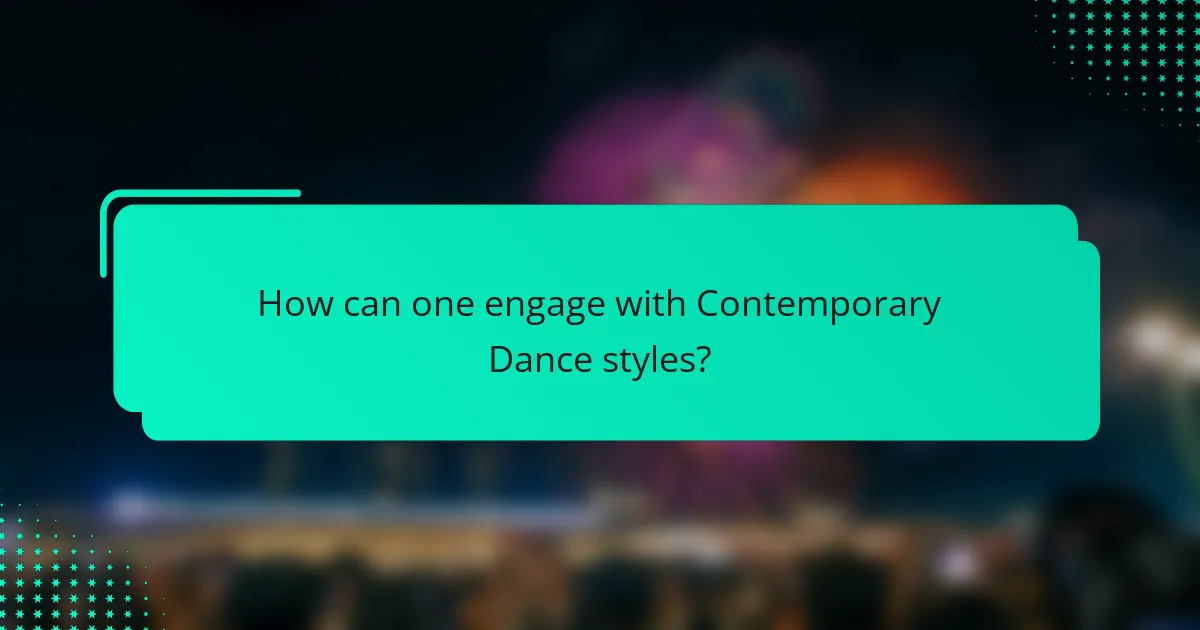
How can one engage with Contemporary Dance styles?
One can engage with contemporary dance styles through classes, workshops, and performances. Participating in classes allows individuals to learn various techniques and movements. Workshops often provide immersive experiences with guest choreographers. Attending performances offers insight into current trends and emotional expressions in contemporary dance. Joining dance communities or online forums can facilitate discussions and connections with other dancers. Many cities have local dance companies that offer opportunities for collaboration. Engaging with contemporary dance can also involve creating personal choreography to explore individual expression. Each of these methods fosters a deeper understanding and appreciation of contemporary dance styles.
What are some best practices for learning Contemporary Dance?
Practice regularly to build muscle memory and improve technique. Consistent training enhances coordination and strength. Attend classes with experienced instructors for proper guidance. Instructors can provide feedback and correction. Explore various styles within contemporary dance to broaden skills. Exposure to different techniques fosters versatility. Record and review your practice sessions. Self-assessment helps identify areas for improvement. Collaborate with fellow dancers for shared learning experiences. Peer interaction encourages creativity and motivation. Set specific goals to track progress. Clear objectives provide direction and focus. Embrace improvisation to develop personal expression. Improvisation nurtures creativity and spontaneity.
How can dancers develop their emotional expression in practice?
Dancers can develop their emotional expression through various techniques and practices. They can engage in improvisation exercises to explore different emotions. This allows them to connect personally with their movement. Additionally, studying character-driven choreography helps dancers embody specific emotions. Practicing mindfulness enhances their awareness of feelings during performance. Feedback from instructors and peers can guide emotional development. Watching performances by expressive dancers serves as inspiration. Finally, journaling about their experiences can deepen their emotional understanding. These methods collectively enhance a dancer’s ability to convey emotion effectively.
What resources are available for aspiring Contemporary Dancers?
Aspiring contemporary dancers have access to various resources to enhance their skills. Dance schools and studios offer classes specifically in contemporary dance. Online platforms like YouTube provide tutorials from experienced dancers. Books on contemporary dance techniques are available in libraries and bookstores. Workshops and masterclasses with professional dancers are frequently held. Networking opportunities exist through dance festivals and competitions. Social media groups focus on contemporary dance, offering support and advice. Additionally, scholarships and grants are available for dance education. These resources collectively support the growth and development of aspiring contemporary dancers.
What tips can enhance a dancer’s experience in Contemporary Dance?
To enhance a dancer’s experience in Contemporary Dance, focus on emotional expression and technical proficiency. Engaging with the music deeply can elevate the performance. Practicing improvisation fosters creativity and adaptability. Attending workshops broadens skills and exposes dancers to diverse styles. Collaborating with other dancers encourages teamwork and collective creativity. Regular feedback from instructors aids in personal growth. Maintaining physical fitness supports endurance and flexibility, essential for contemporary movements. Finally, setting personal goals helps track progress and keeps motivation high.
How can collaboration with other artists enrich Contemporary Dance performances?
Collaboration with other artists can significantly enrich Contemporary Dance performances. By integrating various art forms, dancers can explore new dimensions of expression. For instance, visual artists can enhance the aesthetic appeal through set design and multimedia elements. Musicians can provide original scores that complement the choreography, creating a cohesive experience. Collaborating with writers can deepen the narrative aspect, adding layers of meaning to the performance. Research shows that interdisciplinary projects often lead to innovative outcomes, as seen in the work of choreographer Pina Bausch, who fused dance with theater. This blending of disciplines fosters creativity and broadens the audience’s engagement. Thus, collaboration amplifies the emotional impact and artistic depth of Contemporary Dance.
What are common challenges faced by dancers in this genre?
Dancers in contemporary dance face several common challenges. Physical injuries are frequent due to intense movement and flexibility demands. Emotional expression can be difficult, as it requires vulnerability and authenticity. Additionally, maintaining stamina during prolonged performances is essential. The need for constant innovation puts pressure on dancers to create unique choreography. Collaboration with other artists can lead to conflicts in creative vision. Access to quality training and resources may be limited in some regions. Finally, balancing dance with personal and professional life poses a significant challenge for many dancers.
Contemporary Dance Styles encompass a range of diverse dance forms that emerged in the mid-20th century, emphasizing individual expression and creativity. This article explores the key characteristics, historical influences, and emotional expression within contemporary dance, highlighting techniques such as release technique, floor work, and improvisation. It also examines current trends in choreography, including the integration of technology and social themes, as well as emerging styles and fusion techniques that expand the boundaries of contemporary dance. Additionally, the article discusses best practices for learning and engaging with contemporary dance, providing resources and tips for aspiring dancers.
